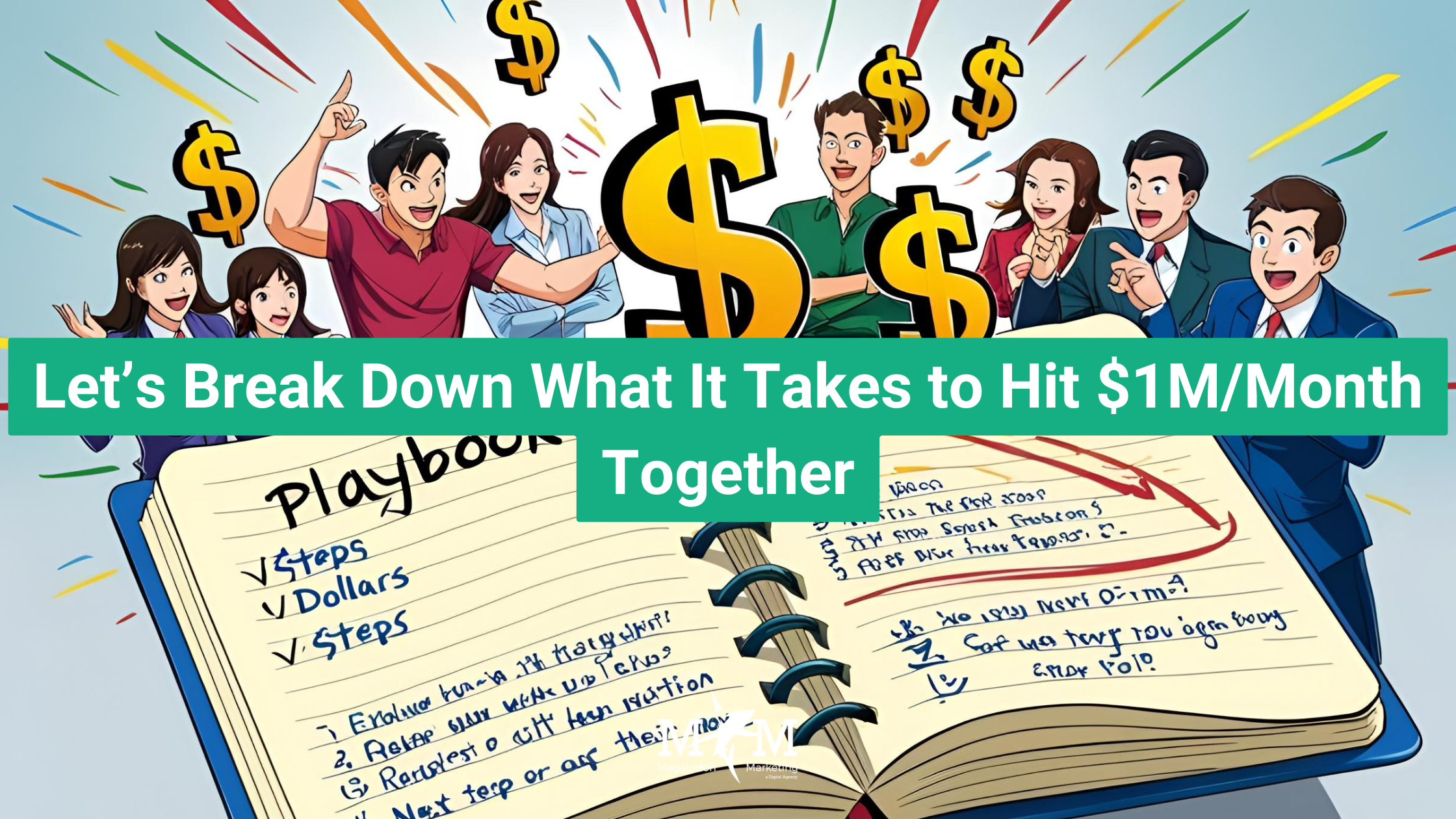I hope you enjoy reading this blog post. If you want my team to just do your marketing for you, click here.

I hope you enjoy reading this blog post. If you want my team to just do your marketing for you, click here.
Author: Jeremy Haynes | founder of Megalodon Marketing.

Earnings Disclaimer: You have a .1% probability of hitting million dollar months according to the US Bureau of Labor Statistics. As stated by law, we can not and do not make any guarantees about your own ability to get results or earn any money with our ideas, information, programs or strategies. We don’t know you and, besides, your results in life are up to you. We’re here to help by giving you our greatest strategies to move you forward, faster. However, nothing on this page or any of our websites or emails is a promise or guarantee of future earnings. Any financial numbers referenced here, or on any of our sites or emails, are simply estimates or projections or past results, and should not be considered exact, actual or as a promise of potential earnings – all numbers are illustrative only.
Watch the full video breakdown on this topic here.
Key Takeaways (Read These Twice)
When I plan, my pen lands on $1,000,000 cash-collected in 30 days. Not 250 k, not 500 k. I don’t water down the dream with “stepping-stone” milestones. That monster number sharpens every decision.
Quick detour you’ll appreciate. Last quarter I prepped this very lesson while fighting a migraine so vicious the aura blinded half my vision. Why push through? Because successful scaling isn’t a motivational meme—it’s certainty born from clean statistics. When the numbers are undeniable, you keep going, blurred vision or not.
Most founders lie to themselves here. If you charge $5 k but after payment plans you collect $3,700, the $3,700 matters. Exaggerate this figure and the rest of your math is fantasy land.
Take 30 seconds right now. Write down:
Average monthly dollars that actually clear your account per customer.
Grab the calculator:
javaCopyEditClients Required = Monthly Target ÷ Average Cash Collected
My first pass:
Clients needed: 100.
One hundred accounts at my then-current service model = a logistical nightmare—three offices, 27 staff, stress for breakfast. The moment I saw that, I knew I had to rewrite the offer.
So I flipped it: 10 clients at $100 k each. Same revenue, radically better life.
Write your trio of numbers now: big target, average cash in, required clients.
Circle one word next to that required-clients figure:
Realistic or Unrealistic
If it’s unrealistic, jot the reasons:
Beside every Why, sketch a Solution. Can you raise price? Shift to group delivery? Hire closers?
Finally, pair each solution with the Reason it excites you. More freedom? Higher margin? Fewer employees? The reason sells you on making the change.
When I made the jump to $100 k retainers, the selling points were oxygen: less staff, richer clients, four-hour months, new supercars guilt-free.
Do your reasons peel the “unrealistic” sticker off the math? Good. Onward.
Big-picture targets become mundane when you walk them downstream through every conversion step.
Mason is a killer copywriter who needs 430 new buyers every month at roughly $3,500 cash-collected to land $1.5 M/month.
His funnel today: pure organic content kicking out ≈550 booked calls monthly.
Wanted outcome: 430 sales
Closer win-rate: 45 %
→ Calls with closers needed: 956
Show-rate: 60 %
→ Calls that must be scheduled: 1,593
Organic gives him one-third of that. The remaining 1,053 scheduled calls have to come from paid traffic.
We overshoot cost-per-call to be safe: $150.
Ad spend required: 1,053 × $150 = $157,950/month.
If his paid show-rate or close-rate droops even a hair, spend climbs toward $238 k. But with numbers this explicit Mason can decide, hire, and budget with both eyes open.
A different client runs a single monster webinar each month:
Her million-a-month dream required 25 k paid registrants.
I deliberately over-estimated CPL to $10, under-estimated show-rate to 15 % (she historically hit 20 %), and under-estimated close-rate to 5 % (she’d done 7 %).
Math:
Budget? 25 k × $10 = $250 k. Within two weeks of launch we’d already booked 14 k registrants and were on pace for the full 25 k with nothing but retargeting—no cold traffic required.
Why did she wire the quarter-million happily? Statistics bring certainty; certainty neutralizes risk.
Notice the pattern:
If the deal still cash-flows under worst-case, you green-light it and stomp on the gas. If not, you tweak price, tweak offer, or add a revenue stream.
I wanted my agency income alone to carry the million, but realism said “stack the deck.” So I added $200 k/month in consulting retainers.
Could you spin up a mastermind? License your proprietary systems? Build a high-ticket training for in-house teams? If the answer is “obviously,” that stream isn’t a distraction—it’s a probability boost.
Mason could carve $500 k/month by charging businesses $10 k/month to train entire copy departments. He has 8 000 students already. Converting 6 % (just 50 buyers) fills the gap—and slashes his 5,160-sales-per-year burden down to 50.
That’s what stacking revenue streams can do to the math.
A Beverly Hills hypnotist bills $1 M a year—$83 k a month!—to whisper sweet affirmations into twelve rich minds. No trackable ROI dashboard. Pure intangibles.
If clients pay that for unprovable value, why would you flinch at $10 k, $20 k, or even $100 k when your service literally spikes their revenue?
Remember:
The only difference between $3 k and $30 k is the conviction in the seller’s voice.
Sell yourself first, then quote the number without a tremor.
Whether you’re migraine-blurry at the whiteboard or sipping Brut on a boat, the framework is identical:
Do the math conservatively, commit violently, and watch the month you crack seven figures feel downright inevitable.
No fairy dust. No rah-rah hype. Just math, margin, and the guts to charge what you’re worth.
Now go tighten those stats and claim your million.

Jeremy Haynes is the founder of Megalodon Marketing. He is considered one of the top digital marketers and has the results to back it up. Jeremy has consistently demonstrated his expertise whether it be through his content advertising “propaganda” strategies that are originated by him, as well as his funnel and direct response marketing strategies. He’s trusted by the biggest names in the industries his agency works in and by over 4,000+ paid students that learn how to become better digital marketers and agency owners through his education products.

Jeremy Haynes is the founder of Megalodon Marketing. He is considered one of the top digital marketers and has the results to back it up. Jeremy has consistently demonstrated his expertise whether it be through his content advertising “propaganda” strategies that are originated by him, as well as his funnel and direct response marketing strategies. He’s trusted by the biggest names in the industries his agency works in and by over 4,000+ paid students that learn how to become better digital marketers and agency owners through his education products.
This site is not a part of the Facebook website or Facebook Inc.
This site is NOT /endorsed by Facebook in any way. FACEBOOK is a trademark of FACEBOOK, Inc.
We don’t believe in get-rich-quick programs or short cuts. We believe in hard work, adding value and serving others. And that’s what our programs and information we share are designed to help you do. As stated by law, we can not and do not make any guarantees about your own ability to get results or earn any money with our ideas, information, programs or strategies. We don’t know you and, besides, your results in life are up to you. Agreed? We’re here to help by giving you our greatest strategies to move you forward, faster. However, nothing on this page or any of our websites or emails is a promise or guarantee of future earnings. Any financial numbers referenced here, or on any of our sites or emails, are simply estimates or projections or past results, and should not be considered exact, actual or as a promise of potential earnings – all numbers are illustrative only.
Results may vary and testimonials are not claimed to represent typical results. All testimonials are real. These results are meant as a showcase of what the best, most motivated and driven clients have done and should not be taken as average or typical results.
You should perform your own due diligence and use your own best judgment prior to making any investment decision pertaining to your business. By virtue of visiting this site or interacting with any portion of this site, you agree that you’re fully responsible for the investments you make and any outcomes that may result.
Do you have questions? Please email [email protected]
Call or Text (305) 704-0094